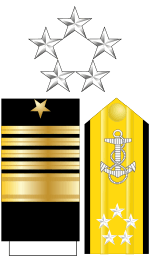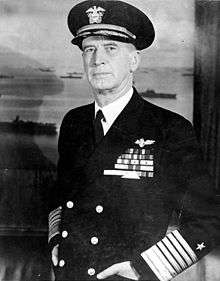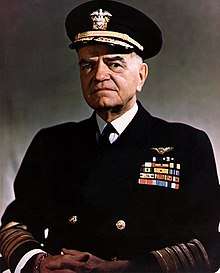Fleet admiral (United States)
Fleet admiral (abbreviated FADM)[1] is a five-star flag officer rank in the United States Navy whose rewards uniquely include active duty status for life.[2] Fleet admiral ranks immediately above admiral and is equivalent to General of the Army and General of the Air Force. Although it is a current and authorized rank, no U.S. Navy officer presently holds it, with the last U.S. Navy fleet admiral being William Halsey Jr., who was promoted to the rank in December 1945.
| Fleet admiral | |
|---|---|
 Fleet admiral collar device, shoulder board, and sleeve stripes. | |
 Flag of the fleet admiral | |
| Country | |
| Service branch | |
| Rank | Five-star |
| NATO rank | OF-10 |
| Non-NATO rank | Five-star rank |
| Formation | December 14, 1944 |
| Next higher rank | Admiral of the Navy |
| Next lower rank | Admiral |
| Equivalent ranks | |
History
World War II
The proper rank of fleet admiral was created in 1944 in order to give United States military officers comparable rank to five-star officers of allied nations. The rank of fleet admiral was created by an Act of Congress for four officers to hold on a temporary basis under Pub.L. 78-482 on December 14, 1944.[3] The rank was made permanent for the four individual holders by Pub.L. 79–333 on March 23, 1946.[4] Although Congress authorized the promotion of Omar Bradley to the five-star rank of General of the Army in 1950 while serving as Chairman of the Joint Chiefs of Staff so that he would be of the same rank as General of the Army Douglas MacArthur, the theater commander in Korea, there has been no new legislation authorizing the use of the rank of fleet admiral since 1946.
It was held during and after World War II by the following officers:
| Name | Portrait | Date of Rank (Age) | Retired | Deceased (Age) |
|---|---|---|---|---|
| William D. Leahy |  |
15 December 1944 (69) | March 1949 | 20 July 1959 (84) |
| Ernest King |  |
17 December 1944 (66) | December 1945 | 25 June 1956 (77) |
| Chester W. Nimitz | .jpg) |
19 December 1944 (59) | December 1947 | 20 February 1966 (80) |
| William Halsey Jr. |  |
11 December 1945 (63) | March 1947 | 16 August 1959 (76) |
The timing of the first three appointments was carefully planned, such that a clear order of seniority and a near-equivalence between the services was established for the Generals of the Army promoted at the same time. General Marshall was promoted to General of the Army on December 16, 1944; General MacArthur was promoted on December 18, 1944; General Eisenhower was promoted on December 20, 1944, and General Arnold was promoted on December 21, 1944. He would later be laterally promoted to General of the Air Force on May 7, 1949 after the Air Force was created as a separate service as part of the National Defense Act of 1947.
The insignia for a fleet admiral is composed of five silver stars in a pentagonal design. Worn on the service dress blue uniform sleeve was a gold stripe two inches wide surrounding the sleeve two inches from the cuff with four half-inch stripes placed at 1/4 inch intervals. The single gold five-pointed star, one ray down, worn above the top stripe was not part of the rank, but indicated the wearer to be a line officer.
Post-World War II
Another contender to receive the rank of fleet admiral was Admiral Raymond A. Spruance; the choice between him and Halsey was an issue that occupied several months of deliberation, before Admiral King finally chose Halsey. Purportedly U.S. Representative Carl Vinson, chairman of the House Armed Services committee and a strong supporter of Halsey, was responsible for blocking subsequent efforts to promote Spruance to fleet admiral (although his promotion continued to be blocked after Vinson retired).[5] Instead, Spruance's achievements were recognized by the unique honour of a Special Act of Congress awarding him full four-star admiral's salary during the remainder of his life. Spruance expressed the following feelings over the issue:
So far as my getting five star rank is concerned, if I could have had it along with Bill Halsey, that would have been fine; but, if I had received it instead of Bill Halsey, I would have been very unhappy over it.[6]
The first fleet admiral to leave active duty was Ernest King who retired immediately after the conclusion of World War II. Chester Nimitz and William Halsey both retired two years later while William Leahy was the last fleet admiral to leave active duty in 1949. According to Public Law 78-482, fleet admirals on active duty receive the same pay as a Rear Admiral, Upper Half (two star) plus a $5,000 personal allowance, and upon retirement were to receive 75% of their active duty pay.[7] When Public Law 79-333 made the rank permanent for Leahy, King, Nimitz, and Halsey, it also provided for full pay and allowances once those officers retired.[8] As with a general of the army, a fleet admiral was entitled to an office maintained by the Navy along with an aide (of the rank of Captain), a secretary, and an orderly.[9]
Three of the four fleet admirals died in the late 1950s and, by 1960, Chester Nimitz was the sole surviving U.S. Navy fleet admiral. He held a ceremonial post as Navy adviser to the Western Sea Frontier with his quarters based in San Francisco. Nimitz died in 1966 with no further fleet admirals appointed since.
Modern usage
No officers have been appointed to the rank of fleet admiral since William Halsey. The rank of fleet admiral is still maintained as a rank of the U.S. Navy, and could again be bestowed, pending approval of the United States Senate. However, the President, with consent from the Senate, may award a fifth star at any time they see fit.[10][11][12]
In the 1990s, there were proposals in Department of Defense academic circles to bestow a five-star rank on the office of the Chairman of the Joint Chiefs of Staff.[13][14][15]
As recently as the late 2000s, some commentators proposed that the military leader in the Global War on Terrorism be promoted to a five-star rank.[16]
Ranks senior to fleet admiral
When the rank of fleet admiral was created, the Navy declared that George Dewey was senior to the newly promoted five-star officers. Since there was never a scenario where fleet admiral and Admiral of the Navy were active ranks concurrently, the Navy drew no equivalence or relationship of seniority between the two. The Department of the Navy did briefly consider the possibility of a "six-star rank" during World War II, mainly in the event that Douglas MacArthur was promoted to General of the Armies, and the need to provide a similar rank to a Navy officer. However, as MacArthur's promotion was never approved, the Navy dropped the idea for a new version of Admiral of the Navy with no such proposals issued since.
The only other officially recognized United States military rank senior to fleet admiral is General of the Armies. In 1981, an unofficial insignia for "six-star admiral" was created after Congress requested clarification as to what procedure would occur should a Navy officer ever be promoted to an equivalent rank of General of the Armies.[17]
See also
- United States Navy officer rank insignia
- List of U.S. military leaders by rank
- List of fleet and grand admirals
- List of comparative military ranks
- Supreme Allied Commander
References
- s:Public Law 78-482 Pub.L. 78-482 – To establish the grade of Fleet Admiral for the United States Navy; to establish the grade of General of the Army, and for other purposes.
- "Public Law 333, 79th Congress". Frequently Asked Questions. Naval History & Heritage Command. Archived from the original on 2007-10-13. Retrieved 2012-09-12.
- "An Act to establish the grade of Fleet Admiral for the United States Navy; to establish the grade of General of the Army, and for other purposes". 14 December 1944. Archived from the original on 6 February 2012. Retrieved 2012-09-21.
- "Public Law 333, 79th Congress". Frequently Asked Questions. Naval History & Heritage Command. Archived from the original on 2007-10-13. Retrieved 2012-09-12.
- Buell, Thomas (1974). The Quiet Warrior: A Biography of Raymond Spruance. Boston: Little, Brown and Co. p. 435-6. ISBN 0-316-11470-7.
- Buell, Thomas (1974). The Quiet Warrior: A Biography of Raymond Spruance. Boston: Little, Brown and Co. p. 435-6. ISBN 0-316-11470-7.
- s:Public Law 78-482 Pub.L. 78-482 – To establish the grade of Fleet Admiral for the United States Navy; to establish the grade of General of the Army, and for other purposes.
- "Public Law 333, 79th Congress". Frequently Asked Questions. Naval History & Heritage Command. Archived from the original on 2007-10-13. Retrieved 2012-09-12.
- James 1985, pp. 661–662.
- "U.S. Sen. Kasten Pushing Effort To Award Powell With Historic Fifth Star". Jet. 79 (23). March 1991. ISSN 0021-5996. Retrieved February 21, 2011.
...there is a movement afoot in the U.S. Senate to award an historic fifth star to the nation's first Black Joint Chiefs of Staff Chairman Gen. Colin L. Powell for his military proficiency.
- Italia, Bob (1991). Armed Forces: War in the Gulf. Abdo & Daughters. pp. 44–46. ISBN 978-1-56239-026-6. Retrieved February 21, 2011.
- Stephanopoulos, George (1999). All Too Human: A Political Education. Thorndike Press. pp. 330–331. ISBN 978-0-7862-2016-8. Retrieved February 21, 2011.
- Organizing for National Security: The Role of the Joint Chiefs of Staff. Institute for Foreign Analysis. January 1986. p. 11. Retrieved February 21, 2011.
There was some discussion of the proposal to grant the Chairman of the Joint Chiefs five-star rank, as a symbol of his status as the most senior officer in the armed forces.
- Jones, Logan (February 2000). "Toward the Valued Idea of Jointness: The Need for Unity of Command in U.S. Armed Forces" (PDF). Naval War College: 2. ADA378445. Retrieved February 21, 2011. Lay summary.
Promoting the Chairman to the five-star rank and ceding to him operational and administrative control of all U.S. Armed Forces would enable him to provide a unifying vision...
Cite journal requires|journal=(help) - Owsley, Robert Clark (June 1997). "Goldwater-Nichols Almost Got It Right: A Fifth Star for the Chairman" (PDF). Naval War College: 14. ADA328220. Retrieved February 21, 2011. Lay summary.
...Chairman's title be changed to Commander of the Armed Forces and commensurate with the title and authority he be assigned the grade of five stars.
Cite journal requires|journal=(help) - Stringer, Kevin D. (2007). "A Supreme Commander for the War on Terror" (PDF). JFQ. National Defense University Press (44): 23. Archived from the original (PDF) on February 22, 2011. Retrieved February 21, 2011.
The development of a four- or even five- star commander with staff to run the war on terror...
- Congressional Record 1981, Cong. 97 Sess. 1 – Part 8, "Promotion of other service branches to General of the Armies of the United States".